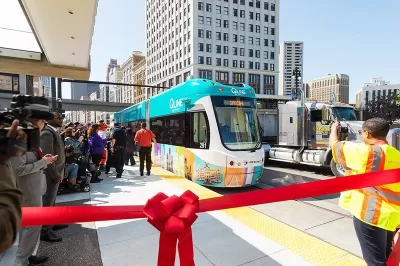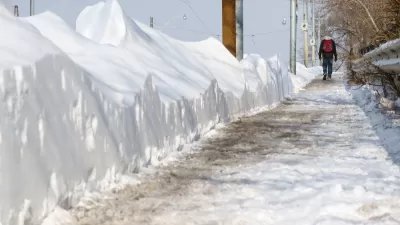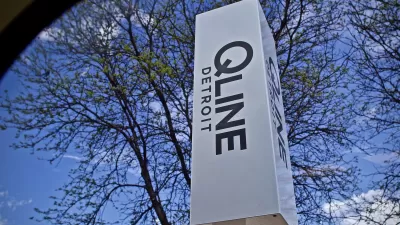The QLine could ride its own dedicated lane and serve a real need for commuters. Instead, it's a slow circulator for a small part of downtown.

Detroit's QLine was originally pitched as an attraction that would raise the value of the land around it, so those who owned that land ended up having an outsized say in its development. It was to be paid for by land owners around the route, "but they soon decided not to cover all the costs, and enlisted government support," Angie Schmitt reports for Streetsblog USA. The QLine eventually received $37 million in capital funds from U.S. DOT and another $10 million from the state of Michigan."
Despite the funding, the streetcar kept a small route a short 3.3-mile route that few have been willing to pay to ride. "It simply doesn’t serve that many people. Ridership dropped about 40 percent, to 3,000 trips per day, after the streetcar started charging a $1.50 fare in August," Angie Schmitt writes. Because it's running on a side alignment in traffic, the streetcar runs fairly slowly and can be blocked by traffic. "Public comments overwhelmingly favored the center-running approach, but 'Gilbert in particular pushed for side alignment,' according to the report, which he again believed would be better for economic development," Schmitt writes.
FULL STORY: How Detroit’s Streetcar Overlooked Real Transit Needs to Satisfy a Well-Connected Few

Alabama: Trump Terminates Settlements for Black Communities Harmed By Raw Sewage
Trump deemed the landmark civil rights agreement “illegal DEI and environmental justice policy.”

Study: Maui’s Plan to Convert Vacation Rentals to Long-Term Housing Could Cause Nearly $1 Billion Economic Loss
The plan would reduce visitor accommodation by 25% resulting in 1,900 jobs lost.

Planetizen Federal Action Tracker
A weekly monitor of how Trump’s orders and actions are impacting planners and planning in America.

Wind Energy on the Rise Despite Federal Policy Reversal
The Trump administration is revoking federal support for renewable energy, but demand for new projects continues unabated.

Passengers Flock to Caltrain After Electrification
The new electric trains are running faster and more reliably, leading to strong ridership growth on the Bay Area rail system.

Texas Churches Rally Behind ‘Yes in God’s Back Yard’ Legislation
Religious leaders want the state to reduce zoning regulations to streamline leasing church-owned land to housing developers.
Urban Design for Planners 1: Software Tools
This six-course series explores essential urban design concepts using open source software and equips planners with the tools they need to participate fully in the urban design process.
Planning for Universal Design
Learn the tools for implementing Universal Design in planning regulations.
Caltrans
Smith Gee Studio
Institute for Housing and Urban Development Studies (IHS)
City of Grandview
Harvard GSD Executive Education
Toledo-Lucas County Plan Commissions
Salt Lake City
NYU Wagner Graduate School of Public Service




























